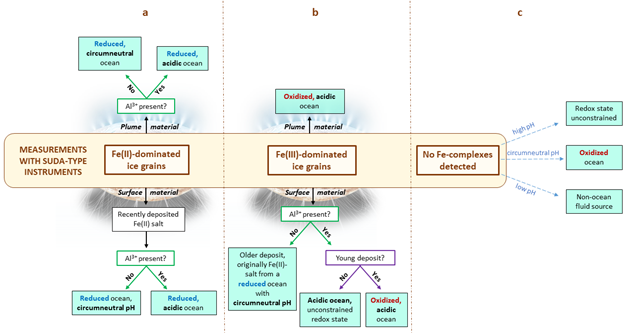Detecting Fe (II) and Fe (III) in Ice Grains with Mass Spectrometry: Implications for the Geochemistry and Habitability of Europa and Enceladus
- 1Institute of Geological Sciences, Freie Universität Berlin, Germany
- 2Institute of Space Systems, University of Stuttgart, Germany
- 3Leipzig Universität, Germany
- 4Leibniz-Institut für Oberflächenmodifizierung (IOM), Leipzig, Germany
- 5Southwest Research Institute, San Antonio, Texas, USA.
Introduction: Characterizing the geochemistry of icy ocean worlds such as Europa and Enceladus is a key step to better constrain the habitability of their subsurface oceans. Transition metals with several oxidation states, such as iron, may be tracers of the oxidation state of icy ocean moon interiors. Their detection, and the characterization of their oxidation states, in Europa’s or Enceladus’ ice grains would provide valuable new data about the geochemistry of both the subsurface oceans and surface processes. Indeed, ice grains are ejected from both moons either in plumes and/or by micrometeorite bombardment, and their analysis can give valuable insight into the composition of subsurface liquid reservoirs. Impact ionization mass spectrometers such as the SUrface Dust Analyzer (SUDA; Kempf et al. 2024) onboard the upcoming Europa Clipper mission can analyze ejected ice grains and detect ocean-derived salts therein.
Methods: To determine if SUDA-type mass spectrometers are capable of detecting iron in different oxidation states, we recorded analogue mass spectra using the Laser Induced Liquid Beam Ion Desorption (LILBID), a technique shown to accurately reproduce data of spaceborne impact ionization mass spectrometers probing ocean worlds (e.g., Postberg et al. 2009, Klenner et al. 2019). Here, we measured Fe2+ and Fe3+ sulfates and chlorides with LILBID, thus determining the mass spectral appearances of these salts as if encased in ice grains from Europa or Enceladus and detected by SUDA-type instruments.
Results: Our results show that impact ionization mass spectrometers can detect and differentiate ferrous (Fe2+) from ferric (Fe3+) ions in both cation and anion modes owing to their tendency to form distinct ionic complexes with characteristic spectral features (Napoleoni et al. 2024). Peaks bearing Fe3+, such as [Fe3+ (OH)2]+ and [Fe3+ (OH)a Clb]- are particularly important for discriminating between the two oxidation states of iron in the sample and even allow quantification of the two species.
Implications for Europa Clipper. This study indicates that SUDA could be a useful tool for the characterization of the oxidation state of the subsurface ocean of Europa by quantification of iron-bearing salts in Europa’s ice grains. In both our analogue experiments and future SUDA mass spectra, the intensities of Fe-bearing ions of different oxidation states and the isotope distribution patterns are informative features that can be used to determine the presence and oxidation state of iron-bearing compounds. The recorded LILBID mass spectra complement a spectral library (Klenner et al. 2022) providing analogue data for SUDA onboard Europa Clipper and potential future Enceladus missions.
Implications for the geochemistry of ocean worlds. The recorded LILBID mass spectra could allow the detection of iron (a key element for life) and the characterization of its oxidation state on the surfaces of icy moons, and potentially from their subsurface oceans (Figure 1). We draw implications for the pH values and oxidation state of Europa’s and Enceladus’ subsurface oceans for difference cases of (non) detection and characterization of iron in ice grains, considering both surface ejecta and plume ice grains. Such characterization of the geochemistry of Europa or Enceladus could be used to test and further develop different models of redox chemistry in their oceans (Ray et al. 2021). It could also have important implications for hydrothermal processes and potential metabolic pathways, such as iron reduction metabolisms (Roche et al. 2023), that may be used by possible extant life in icy moons’ oceans.

Figure 1. Simplified interpretations of the (non) detection and characterization of iron in ice grains from ocean worlds with SUDA-type instruments. From Napoleoni et al., 2024. Three scenarios are considered: (a) detection of Fe(II)-dominated grains; (b) detection of significant Fe(III) in ice grains; (c) no Fe detection. In addition to iron, the detection of aluminum ions (Al3+) in ice grains would support a salt source from an acidic ocean composition. In both scenarios (a) and (b), the case of ice grains originating from a plume (i.e., fresh surface material) is distinct from ice grains originating from the surface, where older material has likely undergone oxidation. In the case of surface material, the age of this material may be constrained by investigating its surface appearance, including geological features.
References
Kempf et al. (2024) Space Science Reviews, in review.
Klenner et al. (2019) Rapid Commun. Mass Spectrom., 33(22), 1751-1760
Klenner et al. (2022) Earth and Space Science, 9(9), e2022EA002313
Napoleoni et al. (2024) The Planetary Science Journal, 5(4), 95
Postberg et al. (2009) Nature, 459, 1098
Ray et al. (2021) Icarus, 364, 114248
Roche et al. (2023) International Journal of Astrobiology, 22(5), 539-558
How to cite: Napoleoni, M., Hortal Sánchez, L., Khawaja, N., Abel, B., Glein, C., Hillier, J. K., and Postberg, F.: Detecting Fe (II) and Fe (III) in Ice Grains with Mass Spectrometry: Implications for the Geochemistry and Habitability of Europa and Enceladus, Europlanet Science Congress 2024, Berlin, Germany, 8–13 Sep 2024, EPSC2024-974, https://doi.org/10.5194/epsc2024-974, 2024.